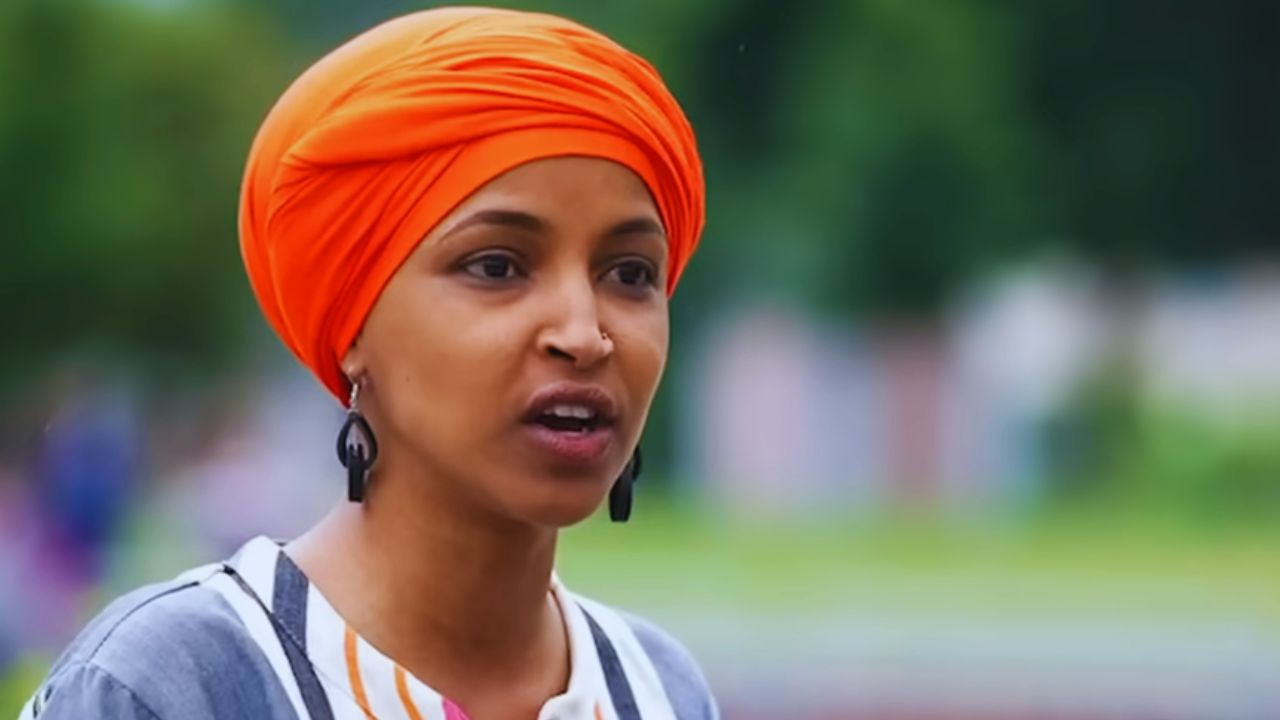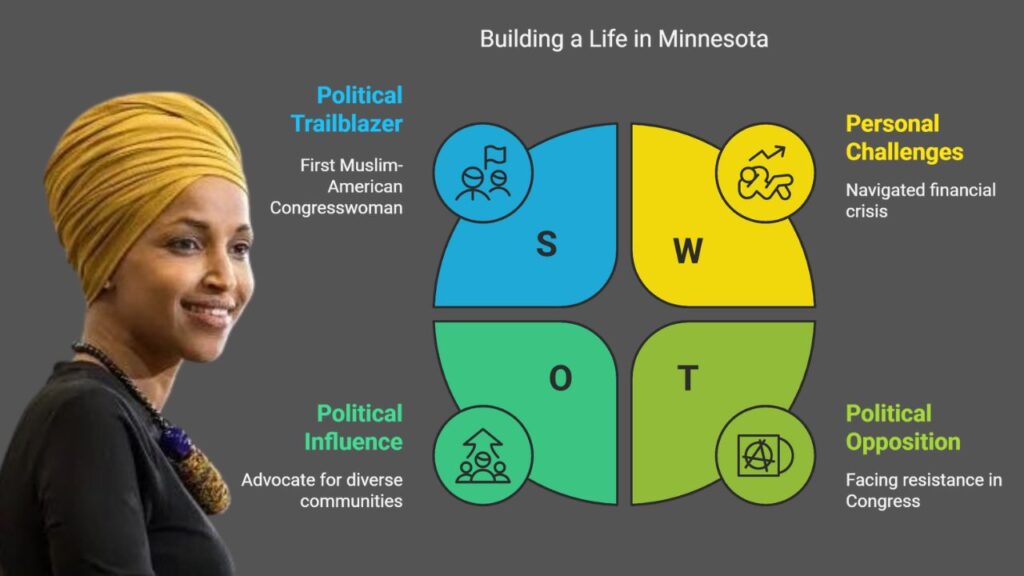Ilhan Omar was born in Mogadishu, Somalia, on October 4, 1982. Her early life was marked by the Somalian civil war. She escaped with her family and lived in a refugee camp before moving to America.
Today, she serves as a member of Congress, representing voices from diverse backgrounds.
After her arrival in the United States, Ilhan Omar’s path led from being a refugee to an influential political figure. She pursued education at North Dakota State University, focusing on political science and international studies.
Her career began on the Minneapolis City Council before making history in Congress as one of the first Muslim-American women and the first woman of color elected from Minnesota.
In Congress, Omar advocates for issues like immigration reform, climate change action, healthcare access through Medicare for All Caucus membership and student debt solutions. She is also part of “The Squad,” pushing progressive policies alongside Reps Ayanna Pressley, Rashida Tlaib, Alexandria Ocasio-Cortez,and Cori Bush.
Her work extends across various committees such as Homeland Security and Health, Education Labor and Pensions; supporting significant acts like H.R.51 for DC statehood rights.,the Crown Act against hair discrimination,,and H.R.40 exploring reparations proposals.
Omar’s journey—from a young girl fleeing conflict in Somalia to impactful U.S legislator—shows her commitment to justice ,equality,,and voicing essential concerns affecting Americans today.
Key Takeaways
- Ilhan Omar was born in Mogadishu, Somalia, and moved to the U.S. as a refugee.
- She became the first Muslim-American woman in the Minnesota House of Representatives and then served in Congress.
- She earned a degree from North Dakota State University.
- Omar tackles issues like immigration reform, climate change, healthcare access, and student debt solutions.
- Her path took her from fleeing war to becoming an influential voice in American politics.
Early Life in Somalia
Born in Mogadishu, Somalia, on October 4, 1982. She was the youngest of seven children. Her mother passed away when she was two years old. Her father and grandfather took care of her after that.
The Somali Civil War forced her family to flee their home in 1991. They moved to a refugee camp in Kenya, where they lived for four years.
Life in the camp was challenging but taught her resilience and hope. These experiences shaped her into a fighter for change and fairness for all people.
Journey to the United States
Ilhan Omar and her family escaped the civil war in Somalia. They found safety in the United States in 1995, when Ilhan was 12.
- Before moving to the U.S., they lived in a refugee camp in Kenya for four years, facing hard times.
- In 1995, their situation improved. The U.S. gave them asylum, offering a chance at a safer life.
- Their first American home was Arlington, Virginia, marking their new start away from Africa.
- Two years later, in 1997, they relocated to Minneapolis because of its vibrant Somali community.
- In Minneapolis, Ilhan attended Thomas Edison High School and quickly became part of the community there.
- At age 17, she celebrated becoming a U.S. citizen with her family.
Now focusing on Ilhan Omar’s achievements in Minnesota:
Building a Life in Minnesota
Omar and her family found a new home in Minnesota. She graduated high school in 2001, then earned a bachelor’s degree in political science and international studies from North Dakota State University in 2011.
After college, she worked at the University of Minnesota as a nutrition expert and with the Minnesota Department of Nutrition.
She entered politics by joining the DFL Party. In 2016, she became the first Muslim-American woman elected to the Minnesota House of Representatives. Two years later, Omar won a seat in the U.S Congress, succeeding Keith Ellison.
She married Ahmed Abdisalan Hirsi in 2001 and had her first child two years later. The financial crisis of 2008 brought challenges but Omar managed through both personal and professional obstacles.
These experiences influenced her actions and views as a member of Congress.
Takeaways
Ilhan Omar was born in Mogadishu, Somalia. She moved through a refugee camp to the United States. In Minnesota, her life took a new turn. Omar became a member of Congress, representing voices often ignored.
Her journey from Somalia to Congress embodies the American dream.
Find out more about Ilhan Omar’s influential career by exploring how much is Ilhan Omar worth.
FAQs
1. Who is Ilhan Omar?
Ilhan Omar is a member of Congress in the United States, making history as one of the first Muslim-American women to hold this position. She represents Minneapolis City Council and has been an advocate for issues such as climate change, student debt, and immigration system reform.
2. Where was Ilhan Omar born?
Ilhan Omar was born in Mogadishu, Somalia. Her family fled from civil war when she was young and spent four years in a refugee camp before coming to the United States.
3. What are some notable moments from her educational journey?
After migrating to America, she attended Edison High School then went on to North Dakota State University where she studied political science and international studies. Later on, she became a policy fellow at Humphrey School of Public Affairs at the University of Minnesota.
4. What roles did Ilhan Omar have before becoming a congresswoman?
Before being elected into Congress, Ilhan served as the first woman of color to serve on Minneapolis City Council and later joined Minnesota House of Representatives following Keith Ellison’s footsteps.
5. Which committees does Representative Omar serve on now?
Currently serving her term in Congress, Rep.Ilhan plays active roles in several house committees including House Budget Committee; Health Education Labor Pensions (HELP); Homeland Security Governmental Affairs (HSGAC), Ways Means committee; Appropriations Committee among others.
6.What are some legislative efforts that Representative Ilhan has championed?
Rep.Omar has been part of various progressive initiatives including ‘Medicare for All Caucus’, advocating for environmental protection measures against climate change,and supporting acts like ‘Protecting Right Organize Act’ or PRO Act along with ratifying Equal Rights Amendment.She also introduced H.R 40 bill addressing national security concerns.













































